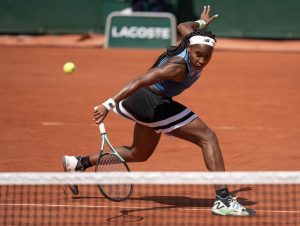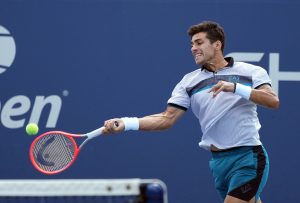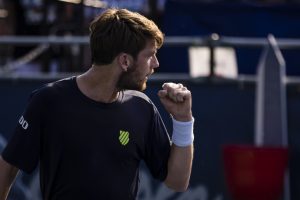Countdown to Roland Garros: In the second part of our series building up to the French Open, Last Word on Tennis looks back at the greatest French Open Men’s Finals.
The French Open is probably the most physically demanding Grand Slam event to win, with the famous red clay sticking to players’ shoes and shirts and draining them of energy. That is true of even the most run-of-the-mill first round match, but a men’s singles final in Paris is perhaps the ultimate test of a player, punishingly probing not only their tennis skills but their athleticism and stamina. Here are the five finest French Open men’s finals.
5. 2004: Gastón Gaudio beats Guillermo Coria (0–6, 3–6, 6–4, 6–1, 8–6)
Such has been Rafael Nadal’s dominance of the French Open since he first won it in 2005 that it is arguable there have not been any great Paris finals since he came to the fore. Even the great Roger Federer has been unable to extend him to five sets in any of the four French finals that they have played. So one has to go back to the last tournament before the “Rafa era” began to find the last truly great French Open men’s final.
The 2004 French final between two Argentine clay court specialists – Gastón Gaudio and Guillermo Coria – was extraordinary in many ways but it was most notable because there have been few bigger underdogs in a Grand Slam final than Gaudio that year. Guillermo Coria was the red-hot favourite on the red dirt, because for a brief period – between Gustavo Kuerten’s hat-trick of French Open titles and Rafa Nadal’s astonishing feat of winning nine French Opens – he was the best clay court player in the world. He had demonstrated that convincingly in the semi-final, when he beat Britain’s Tim Henman in four sets, including a 6-0 third set. Henman, of course, was a grass court specialist – he was one of the last true serve-volleyers in the game – but he was a redoubtable competitor on all surfaces and Coria’s superb and graceful despatching of him installed him as most people’s pick for the title, especially as he was facing Gastón Gaudio and not David Nalbandian, a former Wimbledon finalist who Gaudio surprisingly beat in straight sets in their semi-final.
Coria became an even hotter favourite after he won the first two sets of the final, “bagelling” Gaudio 6-0 in the first set and then breaking him again in the second set to take that 6-3. But then, quite unexpectedly, came one of the greatest ever comebacks in a Grand Slam final and perhaps the greatest ever comeback in a French Open men’s final. As if realising that he had nothing left to lose, Gaudio went on the attack from the third set onwards and as Coria seemed to succumb to complacency he won the next two sets, including a dominant fourth set that he won 6-1. Thus the stage was set for a truly monumental final set, which Gaudio finally won 8-6, to secure his first and only Major win.
The aforementioned Tim Henman has often said that Gaudio had a career that was almost the polar opposite of his own, because for long periods Gaudio was virtually a journeyman, unlike Henman, who was a top 10 player for much of his career. Nevertheless, for one glorious afternoon at Roland Garros, Gaudio cast off any vestige of inferiority and ultimately outlasted his fellow Argentine to win a Major. As for Coria, he was never the same player again and, like Henman, never won the Grand Slam title that his talent merited.
4. 1999: Andre Agassi beats Andrei Medvedev (1–6, 2–6, 6–4, 6–3, 6–4)
1999 was a vintage year for the French Open. Not only did Steffi Graf win her final Grand Slam title, beating Martina Hingis (who was nearly a decade younger than her) in a superb women’s final, but her future husband, Andre Agassi, completed his own career Grand Slam by finally winning in Paris. Consequently, there can be little doubt as to which Prince track is the favourite in the Graf-Agassi household.
Agassi had already lost two French Open finals nearly a decade before. In 1990, he was a shock loser in four sets to Ecuador’s Andrés Gómez and a year later he lost a five-set epic to his fellow American, Jim Courier, who may have lacked Agassi’s shot-making genius but outran and out-hustled him on the burning-hot Paris clay. Agassi did not reach another French Open final until the end of the decade, after his “wilderness years” of the mid-1990s, when he plunged down the world rankings and, as he later admitted in his astonishingly frank autobiography Open, experimented with several illegal substances, including crystal meth. Nevertheless, when he reached his third French Open final in 1999 against the largely unsung Ukrainian, Andrei Medvedev, Agassi was a firm favourite.
What followed, however, was not only a truly great final but a demonstration of the element of tennis that perhaps sets it apart from all other sports. Medvedev shocked Agassi and the gathered Parisians by winning the first two sets for the loss of only three games. Agassi was perhaps overwhelmed by the prospect of both joining the exclusive club of men who have won all four Grand Slam events and doing something that his greatest rival, Pete Sampras, never achieved, namely winning the French Open. He admitted afterwards that he simply played terribly in the first two sets and was hanging on in the third until the tide turned in his favour. Indeed, time was in his favour too, because, as Agassi famously said afterwards, unlike in most other sports where a player or a team can build up a big lead and then simply see out time, Medvedev had to win the match. He could not simply hang on grimly for the win, wasting time in the process, but actually had to take a third set to claim the title. Ultimately, he proved unable to, as Agassi, cheered on by a typically partisan Parisian crowd, finally won in five sets to complete the coveted career clean sweep in the Majors.
3. 1989: Michael Chang beats Stefan Edberg (6–1, 3–6, 4–6, 6–4, 6–2)
Like Gastón Gaudio 15 years later, Michael Chang, the 1989 French men’s champion, was ultimately a “One-Slam Wonder”, winning only a single Major. If anything though, Chang’s Paris triumph was even more remarkable than that of Gaudio. That is because Gaudio beat one truly outstanding player to claim his French Open crown and that player – Guillermo Coria – was not even a Grand Slam champion; indeed, after losing to Gaudio he never reached another Grand Slam final again. By complete contrast, Chang beat a virtual “who’s who” of men’s tennis in the 1980s to claim his one and only Grand Slam victory.
Chang’s odyssey really began in the second round, when he beat Pete Sampras. It is undoubtedly true that “Pistol Pete” was yet to start his own era of greatness, which began in 1990 with his own maiden Grand Slam win – the US Open – and continued for the rest of that decade. Nevertheless, Chang was actually younger than Sampras at the time and throughout Sampras’s illustrious career he did not lose many matches 6-1, 6-1, 6-1, as he did to Chang at Roland Garros in 1989.
In the fourth round, Chang met another future Hall-of-Famer in Ivan Lendl, who had already won the French Open title three times in the previous five years. What followed was an absolutely extraordinary match, a five-set marathon that culminated in Chang completely bamboozling the indomitable Czech in the fifth set by making an under-arm serve at one key point. As if outraged by this seemingly amateurish antic, Lendl lost his famous cool and, after winning the first two sets, eventually lost the match, 6-3 in the fifth.
Chang was not done there, though. In the final, he faced another multiple Grand Slam champion, Stefan Edberg. Like Sampras and Tim Henman, Edberg was a serve-volleyer, and a magnificent one at that, as he demonstrated in edging his three-final Wimbledon series with Boris Becker 2-1. However, even if clay was not his best surface, he was still the favourite against Chang. Chang, with all the ignorance and arrogance of youth, cared not a whit.
Few French Open finals, indeed few Grand Slam finals anywhere, have see-sawed as the 1989 final did. Chang astonished Edberg and the watching world by winning the first set 6-1, but then Edberg appeared to assert his superiority by taking the next two sets. It seemed that, after his memorable run, Chang would fall at the last, but that was to reckon without his sheer fighting spirit. Along with the likes of Lleyton Hewitt, another relatively small man in a sport that was increasingly being dominated by giants, Chang was one of the greatest competitors tennis has ever seen, and never more so than in Paris in 1989, when he won the final two sets to take the title.
The single most impressive aspect of Chang’s one Grand Slam win was that he did it when he was so very young. At 17 “and a third” (four months), he remains the youngest ever Grand Slam men’s champion, younger even than Boris Becker when he won Wimbledon (in the process becoming the man who most people still think is the youngest ever male Grand Slam winner). And if Chang could never quite replicate his fabulous French Open form of ’89 (he reached two more Grand Slam finals in 1996, in Australia and the US, but lost them both), the memory of his sole Major win, when he beat three of the greatest male tennis players ever, makes him perhaps the ultimate “One-Slam Wonder”.
2. 1984: Ivan Lendl beats John McEnroe (3–6, 2–6, 6–4, 7–5, 7–5)
Ivan Lendl is now such a famously intimidating presence in the game, even as a coach (he appears to be the one man capable of inspiring Andy Murray to Major wins), that it is almost impossible to believe that there was a time when he was considered to be more flaky than formidable, and yet that was the case for most of the first half of the 1980s. In that period, he lost the first four Grand Slam finals that he reached, a record that Murray would later equal and that perhaps explains the unlikely but uncanny bond between the two men. Moreover, in the Paris spring of 1984, he seemed well on his way to making it a full handful of losses in Major finals until he somehow stunned the world and his opponent, the mighty John McEnroe, by winning the French Open in five incredible sets.
There is no doubt that the legendary careers of Roger Federer, Rafael Nadal and Novak Djokovic have surpassed that of McEnroe. McEnroe himself acknowledges that by naming all three of them in his own top five players ever, alongside Pete Sampras and Rod Laver. However, for much of 1984 McEnroe played tennis of a kind that had never been seen before and for sheer invention would probably not be seen again for another two decades, when Federer began his rise to greatness. That brilliant run took McEnroe, an avowed serve-volleyer (like his hero, Laver), to the final in Paris, and against Lendl, who at the time was considered to be something of a choker, he was the firm favourite to become the first American male winner in Paris since the relatively unheralded Tony Trabert in 1955.
The first two sets only seemed to confirm McEnroe’s status as favourite, as he won them relatively easily, 6-3 and 6-2. It seemed only a matter of when he would finish Lendl off, not if. But then, somehow, Lendl cast off the inferiority that he had always seemed to exhibit against McEnroe and with his classical base-line game, which was almost purpose-built for clay, he fought back to win in five.
McEnroe would hold the bragging rights by the end of the year, winning the next two Grand Slam events – Wimbledon and the US Open – with consummate ease, first despatching Jimmy Connors in London with one of the greatest all-round grass court displays ever seen and then beating Lendl in straight sets in New York. But Lendl ultimately had the last laugh for the rest of the decade, as McEnroe failed to build on his annus mirabilis. Instead, it would be Lendl who became the dominant male player for the second half of the 1980s, and it all began with his most astonishing Grand Slam victory of all, in Paris in ’84.
1. 1927: René Lacoste beats Bill Tilden (6–4, 4–6, 5–7, 6–3, 11–9)
The previous four finals on this list are all from the Open era (post-1968), but probably the finest French Open men’s final of them all predates the start of the Open era by nearly sixty years. Nevertheless, such is the legendary status of the 1927 final, between the dashing Frenchman René Lacoste, perhaps the finest and certainly the most famous of the four “Musquetaires” who did so much to make France a great tennis nation, and the then-dominant male player, Bill Tilden, that it demands not just inclusion on this list but the No.1 spot.
From its beginning in 1891, the French Championship (as the tournament was called until 1968 and the coming of genuine, widespread professionalism in tennis) was dominated by French players, with only one non-French winner (Britain’s H. Briggs, who is so little known that his Christian name appears lost to history) in the very first instalment of the tournament. Nevertheless, when Lacoste faced Tilden in 1927, the whole of France feared that Tilden would become the first American winner of their tournament, even though Lacoste had already won in Paris two years previously. That was because Bill Tilden was entirely deserving of his simple, alliterative nickname of “Big Bill”.
Tilden can almost be regarded as the Pete Sampras of his day. Like Sampras, he was a great serve-volleyer, which enabled him to win two Wimbledon titles and six US titles before he faced Lacoste in his first French final. Unfortunately, he was also like Sampras in that he would ultimately never win the French title, but he never came closer to winning it than in 1927.
Lacoste won a tight first set 6-4 before Tilden typically fought back to win the next two sets, 6-4 and 7-5. Then, just when he appeared on the verge of victory, Lacoste summoned up all his shot-making genius to win the final two sets, with the fifth proving particularly memorable. Lacoste finally won it 11-9 and thus maintained French hegemony in their own tournament. In the process, he also did much to dispel the aura of invincibility that had developed around Tilden.
In addition, Lacoste’s triumph at the 1927 French Open laid the groundwork for another, even more famous French win on the tennis court less than four months later, when Lacoste was instrumental in France winning the Davis Cup for the first time by beating the mighty USA – Tilden et al – in the final in Philadelphia. While French players had dominated their own championship on their beloved “terre battue”, they had never really travelled well, as evidenced by their 4-1 thrashing by the USA in the 1926 final. However, when the two teams met again a year later, the French, perhaps inspired by Lacoste’s remarkable win in Paris in the spring of that year, finally showed that their tennis players could travel as well as their wine. They won the final 3-2 and began a period of Davis Cup dominance that lasted until 1933, when they lost, at long last, to a Fred Perry-led Great Britain.
And the next great men’s final could be this year
As I said at the outset, such has been Rafael Nadal’s dominance in Paris since his first win there in 2005 that there has been no truly great men’s final for more than a decade now. However, notwithstanding Nadal’s own re-emergence this year, during which he still remains unbeaten on clay, there is at least a chance of this year’s Roland Garros producing a memorable final. That is because for the first time in a long time there are several legitimate contenders for the crown: Nadal himself, of course; Roger Federer, after his almost unbelievable comeback victory in Melbourne earlier this year; Novak Djokovic, who may not have been anywhere near his best since winning in Paris last year but is still the defending champion; Stan Wawrinka, who blasted Djokovic off court two years ago with one of the most astonishing displays of power-play ever seen in Paris; and Andy Murray, the beaten finalist last year and still the World #1, despite his slump in form this year. And if the suspicion remains that Nadal will still emerge triumphant at the end of the tournament, at least this year there is every chance of his being extended to the full five sets.
Enjoy articles looking back at all-time best players and tennis history in general? Make sure to check out our page devoted to stories appreciating historic achievements in tennis.
Main Photo:






